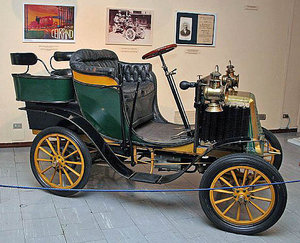Difference between revisions of "Ceirano GB & C"
m |
m |
||
| Line 4: | Line 4: | ||
| − | [[Image:Ceirano 5 HP.jpg|right|thumb| | + | [[Image:Ceirano 5 HP.jpg|right|thumb|300px|Ceirano 5 HP (1901)]] |
The '''Ceirano GB & C''' was a historic automobile company, founded in October 1898 by [[Giovanni Battista Ceirano]], Emanuele di Bricherasio, Attilio Calligaris, Pietro Fenoglio and Cesare Goria Gatti. | The '''Ceirano GB & C''' was a historic automobile company, founded in October 1898 by [[Giovanni Battista Ceirano]], Emanuele di Bricherasio, Attilio Calligaris, Pietro Fenoglio and Cesare Goria Gatti. | ||
Revision as of 18:35, 29 November 2008
The Ceirano GB & C was a historic automobile company, founded in October 1898 by Giovanni Battista Ceirano, Emanuele di Bricherasio, Attilio Calligaris, Pietro Fenoglio and Cesare Goria Gatti.
The headquarters of the new company was set at Turin, where in 1899 it began to build a small car with two seats, the Welleyes designed by Aristide Faccioli. When Welleyes was on markets it was a great commercial success for Ceirano, but managers found themselves unable to cope with the orders of the vehicle. Then in July 1898, the owner of the company, Giovanni Battista Ceirano, decided to sell the plants and patents to Giovanni Agnelli. Therefore, Ceirano had to work for a period in Fiat, but in 1901 left the company for getting to work on their own, along with his brother Matteo Ceirano.
The beginnings of Giovanni Battista Ceirano
The Ceirano brothers (Giovanni Battista and Matteo), were significant figures in the years of the emerging Italian automobile industry.
The elder brother, Giovanni Battista founded in Turin in 1866, the first company that brought his name to build bicycles.
In 1898 the company was renamed "Ceirano and C" and the following year, in 1899 appeared the first car, a design Welleyes 2-cylinder and 3.5 hp.
That same year, Giovanni Ceirano sold his company to a group of investors who founded the "Fabbrica Italiana Automobilia Torino (FIAT) (See story).
The relationship with his brother Matteo
Giovanni Battista Ceirano, remained in the new company (FIAT) about a year, after which and, together with his brother Matteo, founded a new company "Fratelli Ceirano", also in Turin.
In 1903, Matteo left the company and founded "Matteo Ceirano and C", located on the same street. Matteo in 1904 renamed his company "Matteo Ceirano and C - Mark Vetture Itala" (See story ITAL), more popularly known as "Italy". Finally, Matteo left the latter company the following year in 1905 to create, along with Michele Ansaldi, a company called "Ceirano-Ansaldi" in 1906 that eventually led to the formation of SPA-Società Piemontese Automobilia Ansaldi Ceirano, renamed in 1908 SPA Società-Ligure Piemontese Automobilia (See story SPA).
Since 1903, the business lives of the 2 brothers passed separately. Source
SCAT (1906-1923)
Returning to thread the mark "Ceirano" in 1905, Giovanni Battista Ceirano renamed the company "Fratelli Ceirano" which he had founded with his brother Matteo, and gave him the name "Fabbrica minor Torinese Automobilia."
In July 1906, also in Turin, and leaving behind the "Fabbrica minor Torinese Automobilia," Giovanni Ceirano founded SCAT (Società Ceirano Automobilia Torino) (see story). SCAT's headquarters was located in Via Madama Cristina of that Italian city.
The factory was activated immediately (the name of Giovanni Ceirano was a guarantee).
The company began a large way, with 50 workers and produces about 130 cars annually. The first models were produced on 12 hp, 16 hp to 22 hp and finally 1909.
The victories of 1911 and 1912 in the Targa Florio was a sample of Ceirano involvement in the sport of motor.
The company expanded, and in 1914 opened a new plant with 600 workers.
During the War, Scat was obliged to convert their military to civilian production.
Due to accumulated losses, Giovanni left the company in 1917, taking over her a French group of investors (controlled by Henri Brasier, holder of the license to build the Hispano-Suiza V8 engine for aeronautical use).
The French group used the factory Scat for some time to produce aircraft engines. It is estimated that about 1,500 were produced from these prestigious monoblock engines.
After the First World War, Giovanni Ceirano had created another company along with his son Hernesto (Ceirano SA). SCAT had serious financial difficulties and cash flow and over time, Ceirano be managed to take back control of SCAT, merging with its other company in 1923. Source
CEIRANO (1925-1932)
In 1925 restarted production of SCAT under the brand CEIRANO. The launch of the Type 50, or "Ceiranina", formed the basis of production until the end of the 20s in the financial problems that surfaced.
During this period, a car appeared and 1458 cc 4-cylinder with side valves, the 150. This car had a body similar to the Lancia Lambda. Later came the version 150 S.
Later came a derivative of the 150 S, the VVV, with independent suspension.
In 1926 he was presented the type 250, 2297 cc. This car was the last model produced.
Financial problems led to SCAT-CEIRANO outside absorbed by the Consortium Fiat in 1929 to produce exclusive vehicles.
The production of old models continued for some time until 1932, the year in which Fiat decided to cease production. Source
The car
The Welleyes was presented on 30 April 1899, and was designed by Aristide Faccioli, one of the most brilliant car engineers at the time. The car was equipped with two horizontal cylinders, transmission with leather belt and with two gears. The first Fiat made car FIAT 3 ½ HP was direct derivative of this model.


